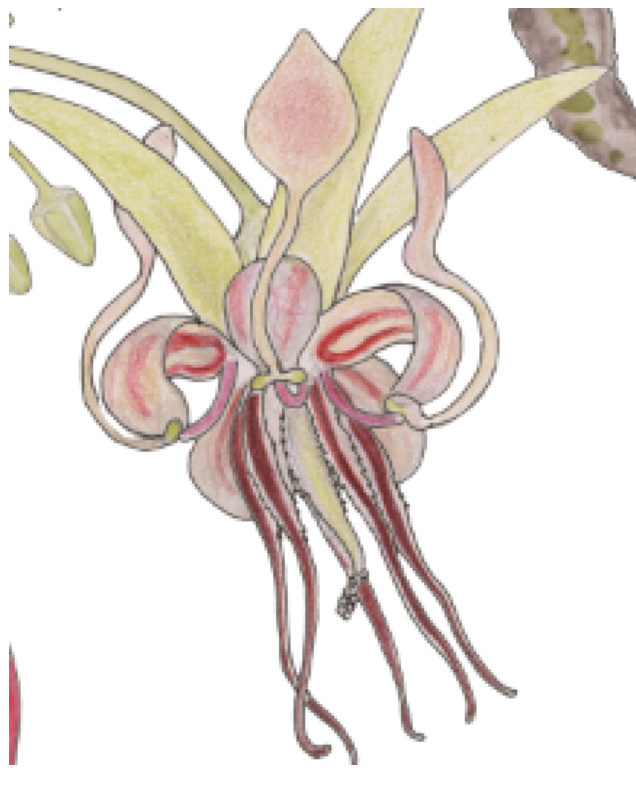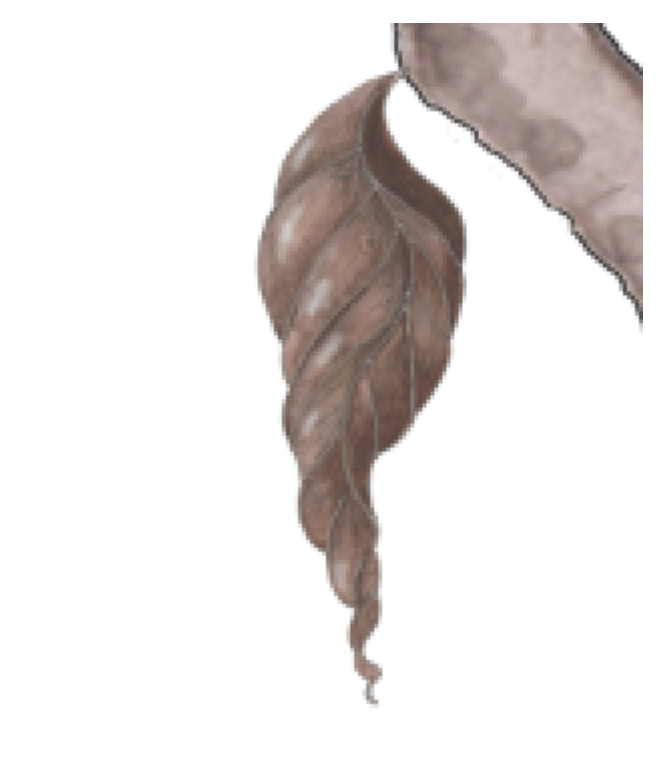Following are some details about the design elements in the Theobroma Tree of Life, an ode to the tree that gives us chocolate, and some of the many species with which is it interconnected in nature.

Theobroma cacao flower
The flower of the cacao tree is only 1cm in width. It is necessary to magnify them to appreciate their unusual structure and delicate beauty. Thousands at a time grow directly from the trunk of the tree and only last a day or two. Various flowers are used in this design, including one which is face on showing the beautiful radial symmetry.

Theobroma cacao pods
Cacao pods vary in colour from ruby red to purple to yellow, which provides this design with some flexibility in colouration. In this design, the Chinese lantern-like pods are not in proportion to the flowers and leaves, but give some indication of their growth on the main stem and older branches, and not on the extremities like most fruits.

Rufus-vented chachalaca
Ortalis ruficauda
A member of an ancient family of birds found in cacao plantations in Venezuela where their old call and proud display is notable and startling.

Young cacao leaves
When they are young, cacao leaves are a striking red, as the plant creates the structure of the leaf without investing in the metabolically-expensive chlorophyll until the leaf is less tender and attractive to herbivores.

Mature cacao leaves
When they are full sized, oblong cacao leaves are leathery and can be up to a foot long. The tree is evergreen, but the leaves are periodically shed.

Dead cacao leaves
In cacao agroforesty, fallen leaves and bark keep the soil moist by forming a protective layer of mulch and later replenishing the soil with nutrients as they decompose. They also provide habitat for insect reproduction which is good for pollination.

Rufous-tailed jacamar
Galbula ruficauda
A jacamar is something between a hummingbird and a kingfisher. They frequent eco-friendly cacao plantations, and are skilled hunters of dragon flies, moths, bees and butterflies.

Red cracker butterfly
Hamadryas amphinome
The common name derives from the cracking noise the males make during display. They use sound as a form of social communication and have been observed in cacao plantations, resting on the bark of the cacao tree where they are camouflaged. Their most common predator is the rufous-tailed jacamar.

Dotted reed frog
Hyperolius guttulatus
Intercropped cacao plantations where pesticides were not used and that were surrounded by primary and secondary forest in Nigeria had visitors of this highly variable and sensitive species. This frog, which breeds in deep ponds is nonetheless able to persist with ecologically-friendly cacao cultivation.

Blushing phantom
Cithaerias pireta
Stunning butterfly with partially transparent wings, found from Mexico throughout the range of the origins of cacao through out South America. They are crepuscular animals happy deep in the dim light of thick vegetation of a cacao plantation or forest.

Midge-inspired flower
Fictitious flower form made of parts of the biting Ceratopogonid midge that may pollinate cacao.
In fact, the pollination of cacao flowers is a great mystery – one study found that the midges we understand to be the main pollinators only accounted for 2% of insect visitors. I opted to create flower forms because the midges themselves are worrying-looking in the extreme, despite the important work they do…

The ringed caecilian
Siphonops annulatus
Caecilians are the least known order of terrestrial vertebrates. They are amphibians, like frogs, and they are predators, like snakes. They are fossorial, so they burrow in the leaf litter and soil. Cacao plantations are good for caecilians, and make an important contribution to the conservation of the Atlantic Forest biome in Brazil, considered the most threatened biodiversity hotspot in South America.

Leaf-footed Coreid bug
Melucha quinquelineata
In 1699, Maria Sybilla Merian and her daughter Dorothea travelled from Amsterdam to Surinam and created one of the first naturalistic illustrations of cacao to reach Europe. This illustration included an unidentified leaf-footed bug. The beautiful leaf footed bug I chose (to pay homage to Merian’s pioneering work) is from Ecuador.

Asplenium cuspidatum
Ferns are a key indicator of a healthy agroforestry system in the tropics – this beautiful Aspleium is native to the neo-tropics within the range of cacao’s origins

Banana pseudostem
Musa paradisiaca or any of 70 other species of Musa
The cacao-pollinating midges are known to lay their eggs in moist habitats such as rotting banana psuedostems, and banana can be an important tree to grow alongside cacao for shade and as an additional crop.









